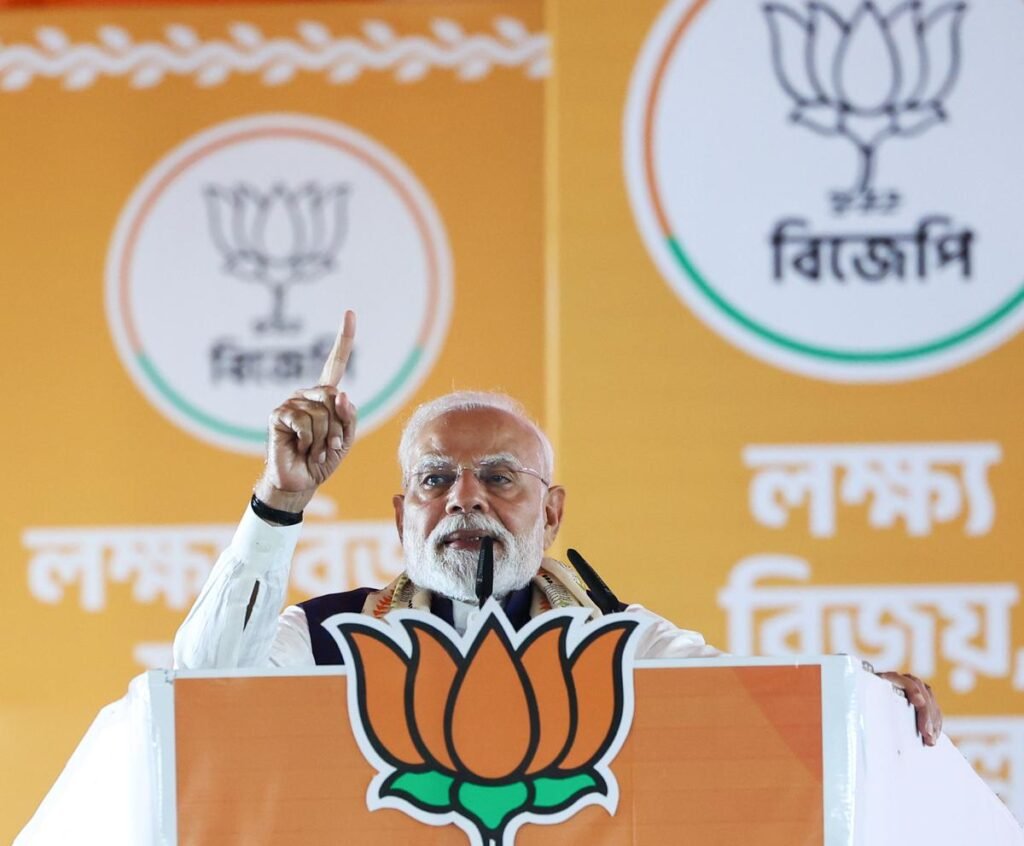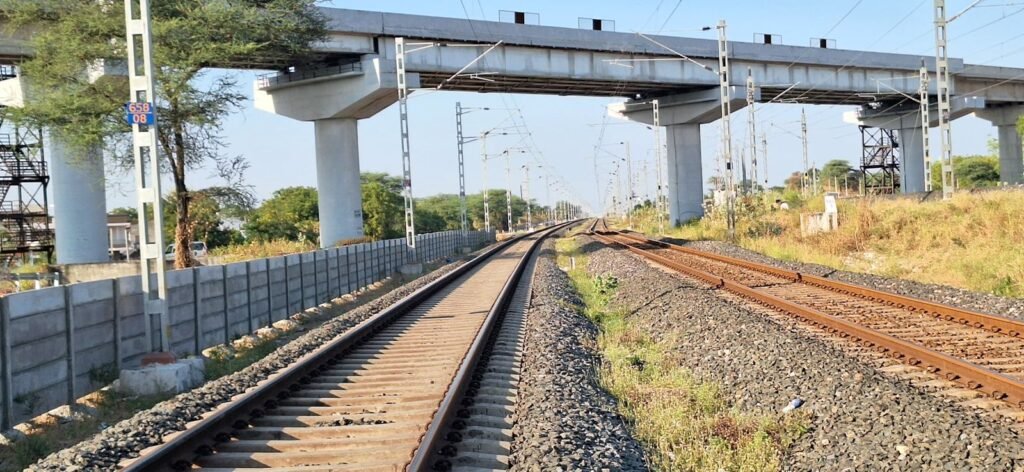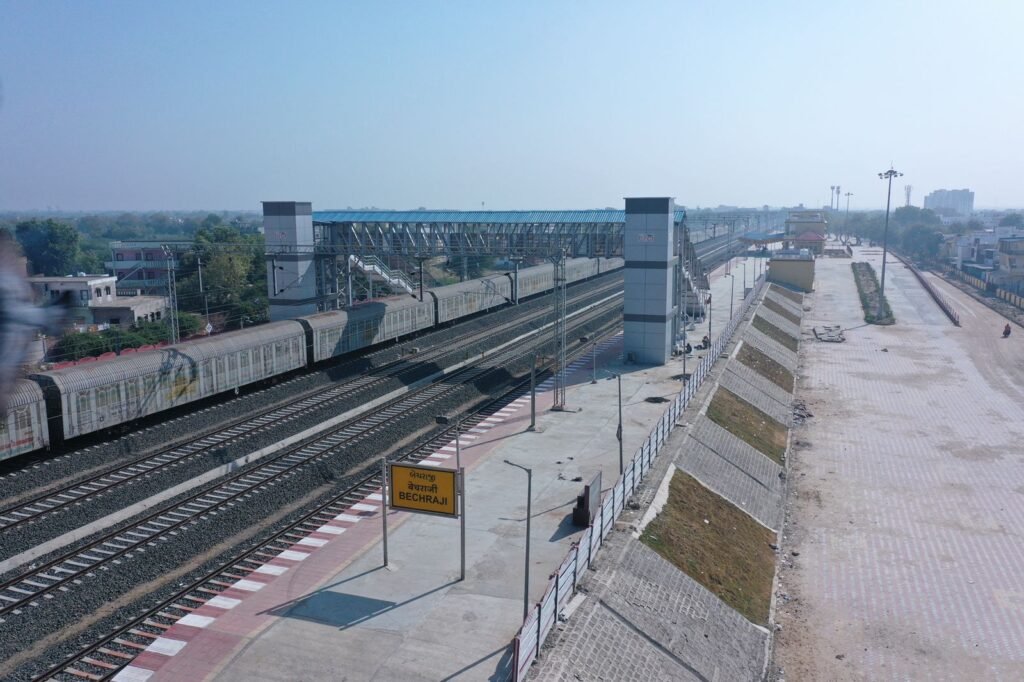In Ahmedabad on August 25, 2025, Prime Minister Narendra Modi dedicated railway projects worth over ₹1,400 crore to the nation—doubling the Mehsana–Palanpur line, converting two North Gujarat routes to broad gauge, and flagging off a Katosan Road–Sabarmati passenger service alongside a car-loaded freight train from Becharaji.

The upgrades unlock capacity on a critical stretch of Western Railway linking Ahmedabad to North Gujarat and onward to Delhi, reduce bottlenecks for passenger and freight movement, and strengthen last-mile rail logistics for Gujarat’s auto-manufacturing cluster around Becharaji/Hansalpur. For commuters, this means more frequent, safer, and faster services; for industry, lower logistics costs and faster turnarounds.
What was inaugurated:
- Mehsana–Palanpur (65 km) doubling, costing~₹530–537 crore, to expand capacity and improve punctuality on a busy intercity and long-distance corridor.
- Gauge conversion to broad gauge on Kalol–Kadi–Katosan Road (37 km) and Becharaji–Ranuj (40 km), together ~₹860 crore, integrating erstwhile meter-gauge links into the main network for higher speeds, heavier loads, and seamless rolling stock deployment.
New/flagged-off services:
- Passenger train: Katosan Road–Sabarmati, improving access for daily riders and religious tourists across Ahmedabad and North Gujarat.
- Car-loaded freight service: From Becharaji, designed to move finished vehicles directly from the auto belt to markets nationwide—supporting Gujarat’s auto ecosystem and cutting truck movements and emissions.
Where the gains accrue:
- Districts benefiting include Mehsana, Patan, Banaskantha, Gandhinagar, and Ahmedabad, with knock-on relief to the Ahmedabad–Delhi artery as capacity frees up for additional paths.
- The Becharaji–Hansalpur area, part of the Mandal–Becharaji auto hub, already hosts major OEMs and suppliers; better rail connectivity deepens just-in-time logistics and export competitiveness.
Broader infrastructure slate:
- While the headline figure for rail is ₹1,400+ crore, the PM’s Gujarat visit also included a ₹5,400-crore multi-sector package—roads, power distribution, and urban upgrades—complementing the rail push with underpasses, overbridges, and widened corridors around Ahmedabad and Mehsana to remove choke points and improve safety.

Cost breakdown (as shared in public briefs):
- Mehsana–Palanpur doubling: ~₹537 crore
- Kalol–Kadi–Katosan Road gauge conversion: ~₹347 crore
- Becharaji–Ranuj gauge conversion: ~₹520 crore
Total: ~₹1,404 crore (rounded as “over ₹1,400 crore” in official communication).
Policy frame:
The projects align with Make in India/Aatmanirbhar Bharat and Western Railway’s ongoing push to debottleneck freight and expand suburban/intercity capacity through doubling and gauge conversions, improving safety, and enabling higher speeds on broad-gauge corridors.
Timelines, Operations, Guidance
- Service roll-out: With lines commissioned and dedicated to the nation, Western Railway will operationalize the Katosan Road–Sabarmati passenger service and the Becharaji car-freight service under regular timetables/booking protocols; commercial circulars and detailed schedules typically follow post-flag-off.
- Capacity utilization: Doubling and gauge-conversion benefits generally materialize over the next few timetable cycles, enabling more train paths and improved punctuality on the Ahmedabad–Delhi axis.
- Complementary road works: New underpasses/overbridges and road widenings around Ahmedabad–Mehsana will synchronize with rail upgrades to cut at-grade conflicts and enhance safety.

According to the Prime Minister’s Office news update dated August 24, 2025, detailing the Gujarat visit and the railway projects worth over ₹1,400 crore, including line specifics, train flag-offs, and supporting road works; corroborated by coverage in Financial Express with itemized cost components; and same-day reporting by India Today.
Conclusion
Gujarat’s latest rail package is not just a ribbon-cutting exercise—it’s a capacity and connectivity upgrade with immediate commuter benefits and hard logistics gains for industry. The Mehsana–Palanpur doubling and broad-gauge conversions stitch North Gujarat more tightly into Western Railway’s trunk routes, while the Katosan Road–Sabarmati passenger link and Becharaji car-freight service exemplify how passenger mobility and freight efficiency can advance together. Backed by accompanying road and power projects, this integrated build-out supports Gujarat’s emergence as a manufacturing and mobility hub and sets up the corridor for faster, safer, and greener transport over the coming years.











